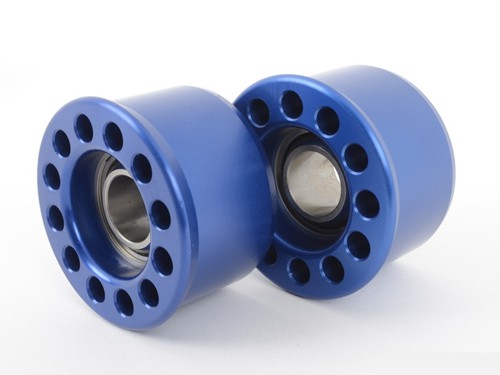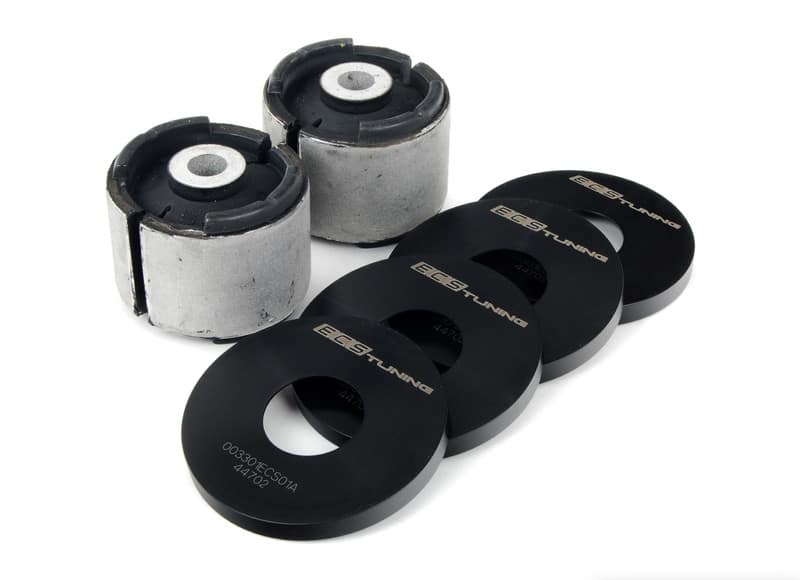To understand why RTABs affect the comfort and handling of your BMW E36, we need to talk about their function. Simply stated, the rear trailing arms on your vehicle connect the rear axle to the frame. Without the rear trailing arms, there would be nothing bracing the axle from twisting or turning from the forces of driving. Without rear trailing arms, the rear wheels would be destabilized and forced off of their correct axis.
The Rear Trailing Arm Bushing is the connection point between the rear trailing arm and the vehicle’s chassis. The RTABs main function is to cushion and soften the movement of the rear suspension while keeping the rear wheels on their correct axis. Factory RTABS on the BMW E36 are made out of rubber, which maximize comfort for street driving, but are less than optimal for the track. Switching to a stiffer RTAB material like polyurethane, Delrin, or aluminum can drastically amp up the handling characteristics of your vehicle, but there is a price to be paid with comfort. So which is the best choice for you?
If your main goal is to retain the same feel and response that your car was delivered from the BMW factory with, then you should install OEM rubber bushings. Rubber bushings allow the rear suspension to fully articulate creating a comfortable controlled ride. If your car is a daily driver or only rolls on street pavement, we suggest installing rubber bushings. The good news is that they are your least expensive option, usually under 50 bucks for a pair.
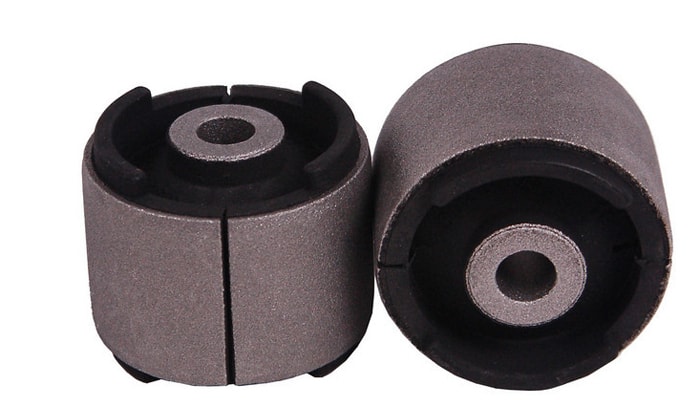
If you are looking for more aggressive handling but want to keep the comfort of a stock rubber bushing, your best choice is to use a rubber RTAB with a nylon or aluminum bushing limiter kit. The addition of a bushing limiter kit virtually eliminates the side-to-side deflection of the rear trailing arm, giving more precise and predictable handling characteristics to your vehicle. The limiter plates are easily mounted to the inside of the trailing arm mount and surround the RTAB to keep lateral movement to a minimum. Adding limiters to your rubber RTABs is considered a “text book” choice for those looking for an enhancement in performance, yet want to retain a comfortable ride. Limiter plates also dramatically extend the life span of of rubber bushings by eliminating their lateral movement. We highly recommend using rubber bushings with limiters for tracking your car or your daily driver – they are the perfect setup for performance and comfort in all driving scenarios.
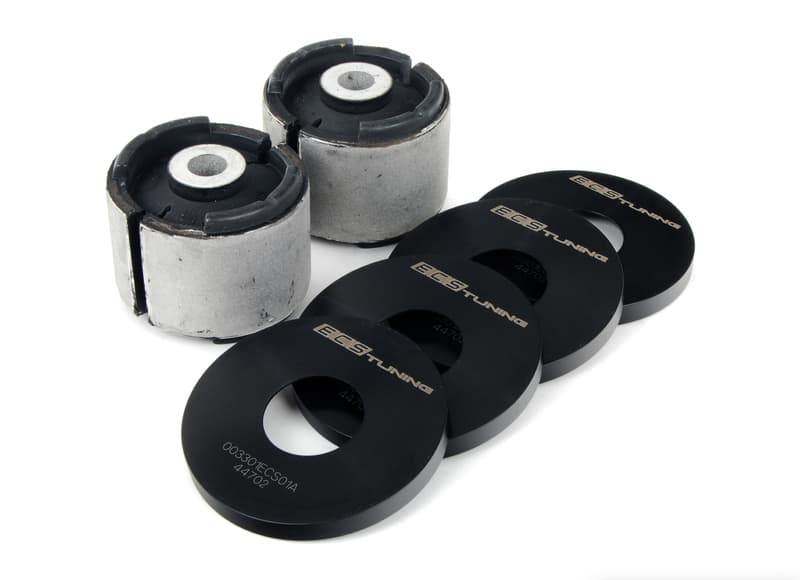
If you research polyurethane rear trailing arm bushings for the BMW E36, you are going to come across a lot of differing opinions on their use. Some claim that polyurethane bushings are a bad choice for RTAB material due to their tendency to “bind” causing strange handling characteristics and early suspension failure within the trailing arm mounts. Polyurethane bushings also have a bad reputation for being noisy (squeaky) if they are not routinely lubricated. There are also those who are big fans of polyurethane RTABs and claim that their stiffness help maintain the car’s geometry better than rubber, giving you better control and handling. Furthermore, many polyurethane RTAB manufacturers are claiming “advancements” in engineering that make their RTABs quieter and more forgiving than older versions.
Whatever you choose to believe, one fact remains-polyurethane RTABs are much stiffer than rubber. If tracking your car has become a high priority, but you still want to retain some degree of comfort while driving around town, then consider using a polyurethane RTAB. They are an excellent choice for track use since they improve steering feel, turn in and overall chassis control. Polyurethane RTABS still offer a small degree of ride comfort for your car, although not as much as a rubber bushing. Before purchasing a set for your car, take into consideration their reputation of being noisy and that they may require frequent lubrication.
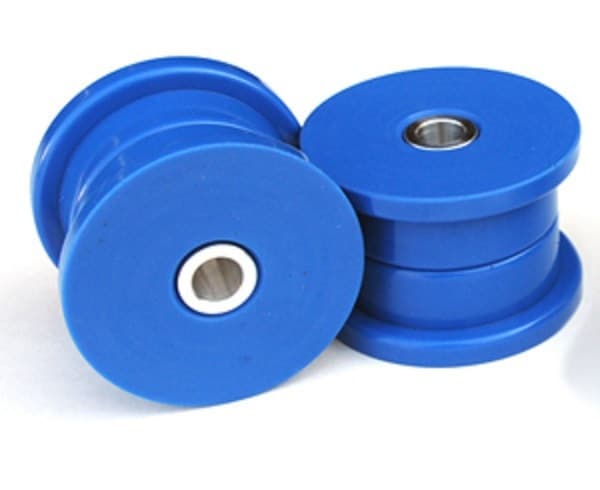
Delrin® is an acetal resin plastic characterized by its high stiffness, strength, hardness and rigidity. It’s a very tough material with a very low coefficient of friction, making it a superior RTAB choice for those looking for the ultimate in racing performance and handling. Due to its zero deflection properties, it offers no protection against vibration or noise. Delrin bushings are highly recommended for track cars only, or for street drivers that do not have a need for comfort or noise dampening.
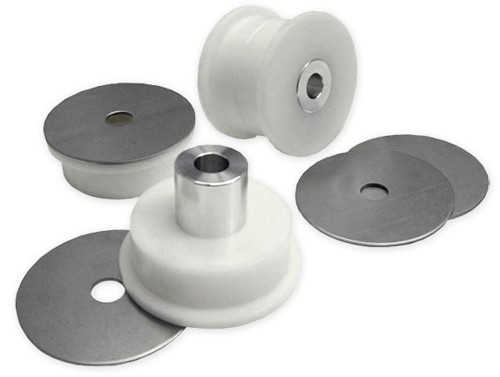
When you ask a true professional what the ultimate RTAB is for track and racing, they will tell you there is substitute for monoball bearing bushings. Monoball bearings offer zero deflection and toe change and the ultimate in performance and handling. Monoball bearing bushings are constructed of an aluminum housing containing a high quality race bearing. The bearing allows the rear trailing arm to hinge vertically while virtually eliminating any lateral movement whatsoever. The results are precision handling and blistering performance. Like the Delrin bushing, monoball bearings are highly recommended for track and racing only.
